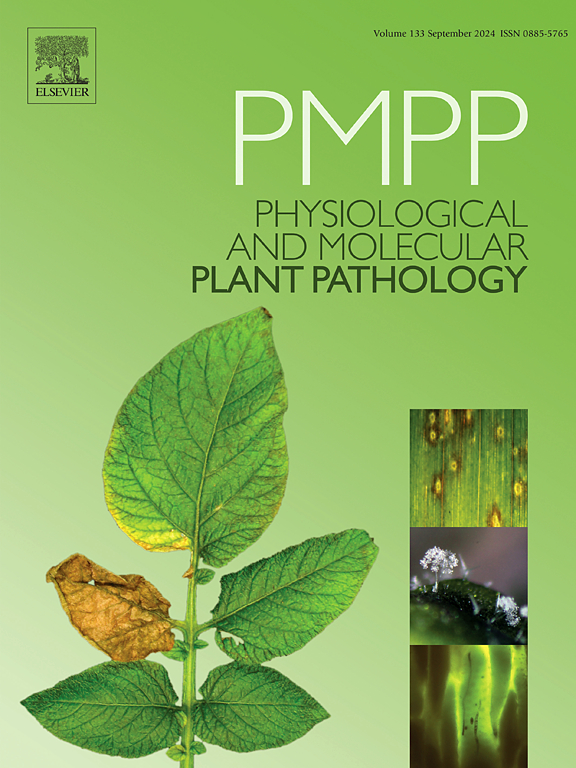Salicylic acid-induced defense responses against a newly identified cotton pathogen, Pantoea vagans
IF 2.8
3区 农林科学
Q2 PLANT SCIENCES
引用次数: 0
Abstract
Bacterial blight of cotton is a severe disease that significantly impacts cotton production worldwide. In 2022, cotton (Gossypium spp. plants exhibiting angular leaf spots, necrotic lesions, and blackened stems were observed in fields across Bahawalpur, Punjab, Pakistan. Pathogen isolation from symptomatic plants yielded Pantoea vagans (strains CPVB#1, CPVB#2, and CPVB#3), identified through morphological, biochemical, and molecular analyses. Molecular identification using 16S rRNA sequencing (GenBank Accession Nos. OQ925871, OQ925897, OQ925910) revealed high sequence similarity (99.8 %, 98.59 %, and 97.78 %) to Pantoea vagans reference strain MN661279. Further confirmation was achieved via multilocus sequence analysis (MLA) of fusA (OR184128–OR184130) and leuS (OR184131, OR188816, OR188817) genes, confirming the close genetic relationship. Our research revealed that, for the first time in Pakistan, Pantoea vagans is causing bacterial blight in cotton, according to our knowledge. To control bacterial blight in cotton, the efficacy of salicylic acid (SA) as a sustainable control method was also evaluated under greenhouse conditions. SA treatments at 0.5 mM, 1.0 mM, and 1.5 mM reduced disease severity significantly, with 1.5 mM SA achieving the greatest suppression (82.3 %). In addition to lowering disease severity, SA treatments increased total phenolic content and enhanced the activity of enzymes that are related to defense mechanisms, including CAT, POD, SOD, PAL and PPO with maximum enzyme activity observed four Days post-treatment. These results demonstrate the potential of SA as an eco-friendly and effective management strategy for bacterial blight in cotton. Further research is warranted to investigate the epidemiology of Pantoea vagans and develop integrated approaches to mitigate its impact on cotton production.
水杨酸诱导的对一种新发现的棉花病原菌的防御反应
棉花细菌性枯萎病是一种严重影响棉花生产的疾病。2022年,在巴基斯坦旁遮普省巴哈瓦尔布尔(Bahawalpur)的田地里,观察到棉花(Gossypium spp.)植物表现出角状叶斑、坏死病变和茎变黑。从有症状的植物中分离出病原菌,通过形态学、生化和分子分析鉴定出了Pantoea vagans(菌株CPVB#1、CPVB#2和CPVB#3)。16S rRNA测序(GenBank登录号:OQ925871、OQ925897、OQ925910)与Pantoea vagans参考菌株MN661279的序列相似性分别为99.8%、98.59%和97.78%。通过对fusA (or184128 ~ or184130)和leuS (OR184131、OR188816、OR188817)基因的多位点序列分析(MLA)进一步证实了二者的亲缘关系。据我们所知,我们的研究首次在巴基斯坦发现,Pantoea vagans正在引起棉花的细菌性枯萎病。为了防治棉花白叶枯病,在温室条件下对水杨酸(SA)作为可持续防治方法的效果进行了评价。0.5 mM、1.0 mM和1.5 mM的SA处理显著降低了疾病严重程度,其中1.5 mM的SA抑制效果最大(82.3%)。除了降低疾病严重程度外,SA处理还增加了总酚含量,增强了与防御机制相关的酶的活性,包括CAT、POD、SOD、PAL和PPO,在处理后4天酶活性最高。这些结果表明,SA作为一种生态友好、有效的棉花白叶枯病防治策略具有潜力。需要进一步的研究来调查Pantoea vagans的流行病学,并制定综合方法来减轻其对棉花生产的影响。
本文章由计算机程序翻译,如有差异,请以英文原文为准。
求助全文
约1分钟内获得全文
求助全文
来源期刊
CiteScore
4.30
自引率
7.40%
发文量
130
审稿时长
38 days
期刊介绍:
Physiological and Molecular Plant Pathology provides an International forum for original research papers, reviews, and commentaries on all aspects of the molecular biology, biochemistry, physiology, histology and cytology, genetics and evolution of plant-microbe interactions.
Papers on all kinds of infective pathogen, including viruses, prokaryotes, fungi, and nematodes, as well as mutualistic organisms such as Rhizobium and mycorrhyzal fungi, are acceptable as long as they have a bearing on the interaction between pathogen and plant.

 求助内容:
求助内容: 应助结果提醒方式:
应助结果提醒方式:


